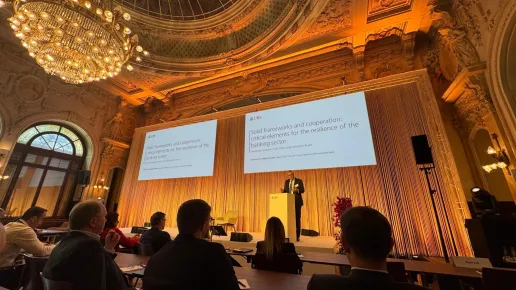[Check against delivery]
Good afternoon, Madam Chair, Honourable Members, ladies and gentlemen.
It is a pleasure to be here with you today.
I would like to seize the occasion of this hearing to give you a snapshot of our work program for 2025 but also what we hope you will do next year.
1. 2025 work program
As you know, in 2024 we began implementing a new strategy, the SRM Vision 2028, which touches upon several aspects of our work.
Let me give you four examples.
First, every year we score the progress that banks have achieved to become more resolvable. As banks have progressed considerably in the last nine years, we are now making a strategic shift to testing these capabilities.
This is why a key item for 2025 is a revamp of how we assess banks’ readiness, taking into account these new testing activities. We have just launched a public consultation about this new approach yesterday and we will organise a public hearing at the beginning of 2025.
Second, in 2025 we will carry out our first on-site inspections, starting no later than January.
These efforts are, by their nature, resource intensive.
This is why next year - third example - we will streamline our resolution plans. We will make them shorter and more risk-based. This should free up resources to deliver on our new projects, while minimising their impact on our budget.
Fourth (and last) example, in 2025 we will work on a digital transformation strategy that will make us more efficient.
As you can see, this work program is very much geared towards efficiency. We want to make sure that resolution planning is not overly burdensome and that our procedures stay light to make us more effective.
2. Important legislative files
President Von der Leyen, last week, told the European Parliament’s Plenary that “we need to streamline our rules to reduce the burden on businesses. And we need to give legal certainty about what we expect from them.”
Honourable Members.
Let me complement that and say that these twin objectives mentioned by President Von der Leyen - 1. clear expectations and 2. streamlined rules - are also important for public authorities, not only for businesses.
This is why, at this time, we need an ambitious agreement on the CMDI review.
CMDI’s original objective is to expand the role of resolution to more small banks. A clear expectation!
The Commission’s proposal offered rules - chiefly a funding solution called “DGS Bridge” – that are streamlined enough to allow us to fulfil that objective.
However, some of the provisions that were introduced in Parliament and in Council risk making the use of the “DGS Bridge” so complex that we will not be in a position to actually fulfil the expectation of a broader scope for resolution. From a practitioner’s perspective, I can tell you that we are far from any simplification goal!
To be clear, CMDI, per se, does not change the way we deal with our larger banks.
However, given the numerous hurdles to activate the DGS bridge in resolution, CMDI may end up incentivising the Banking Union authorities and Member States to deal with smaller bank crises outside of resolution. This would increase fragmentation and bail-out risks.
Objectively, this runs counter to the goal of expanding the role of resolution.
How can this be addressed?
The trilogue should focus on eliminating at least some of the complexity introduced by Council, with over 20 conditions to activate the DGS bridge.
Our preliminary analyses show that these conditions severely curtail the availability of the DGSs bridge, limiting our capacity to use it for only a handful banks.
It would also be important that the “least cost test” is as predictable as possible.
Let me conclude on this point.
As CMDI offers already other very useful and uncontroversial technical improvements, I hope that this text will be finalised as soon as possible.
I also hope that you will be able to find pragmatic landing zones for the more debated parts of the reform. However, please don’t focus on one or two conditions. We need a broader rethink to make this package actionable.
As always, we are ready and willing to provide you with our technical advice at all levels.
3. Conclusion
I have spoken a lot on simplification.
But let me be clear. Obviously, simplification and flexibility should not come at the expense of accountability. That’s why I am here today.
By the way, the SRB will renew half of its board in the next weeks. You will be asked soon to vet a few candidates and decide on our new Vice-Chair and two Board Members. Please consider these appointments a priority.
To conclude, my message here to you is: bank resolutions are a race against time. The simpler and clearer the rules, the higher the chances of success.
I am sure that CMDI, and eventually EDIS, will improve an already solid and tested framework to protect bank clients and taxpayers.
Thank you for your attention!
Contact our communications team
Recent news



Related news and press releases





